Exchange Server 2007 has two primary management interfaces: the Exchange Management Console and the Exchange Management Shell. You've already worked with the Exchange Management Console during the initial deployment process, but I want to spend some more time showing you its key aspects.
The Exchange Management Console is laid out quite a bit differently from its predecessor, the Exchange System Manager of Exchange Server 2003. If you look at Figure 14, you will see that the console is broken down into four different areas: Organization Configuration, Server Configuration, Recipient Configuration, and Toolbox.
Figure 14: Exchange Server 2007's Exchange Management Console.
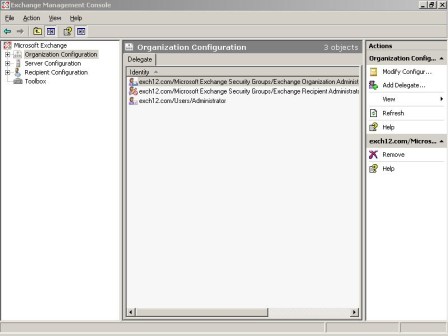
The Organization Configuration container
As the name implies, the Organization Configuration section contains settings related to the Exchange Server organization as a whole. For example, if you look at Figure 15, you'll see that selecting the Organization Configuration container causes the details pane to reveal a list of delegates for the organization.
Figure 15: The Organization Configuration container.
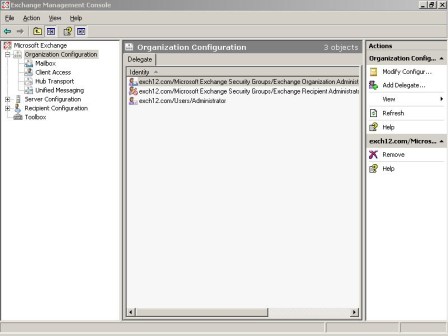
There are four subcontainers beneath the Organization Configuration container related to global settings that apply across the entire Exchange Server organization. For example, the Mailbox container allows you to configure email address formats for the organization and to create new managed content settings. (Managed content settings provide a way for you to specify a retention period for a particular folder, and an action to take when the retention period expires.)
The Organization Configuration section also includes the Client Access container, which is used to configure ActiveSync mailbox policies.
Just below the Client Access container is the Hub Transport container. The Hub Transport container allows you to define your Exchange Server organization's topology. This is where you would go to configure accepted domains, remote domains, and transport rules.
The Server Configuration container
The Server Configuration container is used to store settings related to a specific server. For instance, if you look at Figure 16, you'll see that when you select the Server Configuration container, the details pane displays a list of the roles that are configured on the server.
Figure 16: The Server Configuration container.
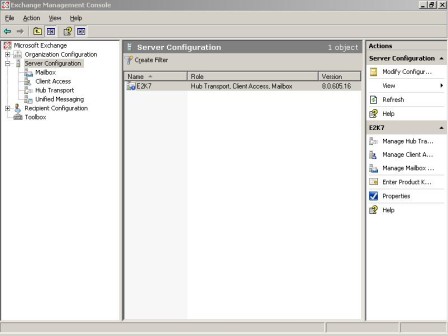
Like the Organization Configuration container, the Server Configuration container also contains a set of subcontainers. These subcontainers correspond to the various roles assigned to the server. Selecting one of these subcontainers allows you to configure options related to the corresponding role -- e.g., the Mailbox container is used for managing Exchange Server stores and storage groups.
The Recipient Configuration container
The Recipient Configuration container is used for managing options related to individual recipients, as shown in Figure 17. This container houses a set of subcontainers used to show recipient resources such as mailboxes, distribution groups, contacts, and disconnected mailboxes.
Figure 17: The Recipient Configuration container.
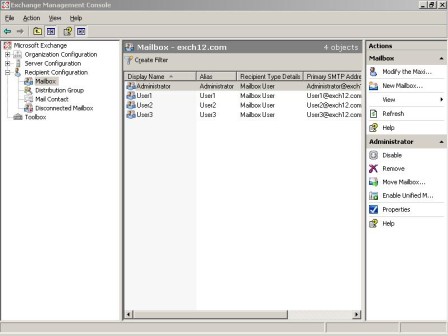
The Toolbox
Over the years, Microsoft has released a number of external tools for Exchange Server. As great as some of these tools have been, there has always been one major underlying problem -- they have not been directly built into Exchange Server.
In Exchange Server 2007, Microsoft finally incorporated the various Exchange Server tools directly into the Exchange Management Console. As you can see in Figure 18, the Exchange Management Console contains a variety of tools related to configuration, disaster recovery, mail flow, and performance. You can run any of these tools from within the Exchange Management Console just by double-clicking on them.
Figure 18: Tools are now integrated into the Exchange Management Console.
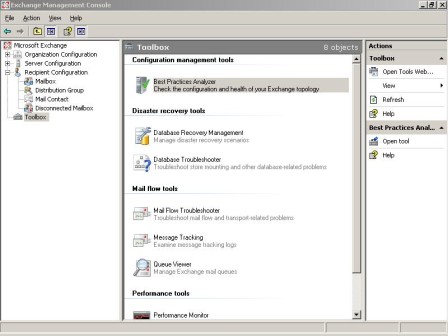
No comments:
Post a Comment